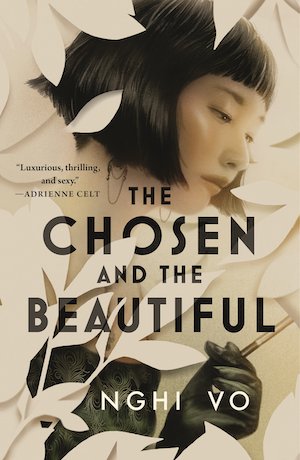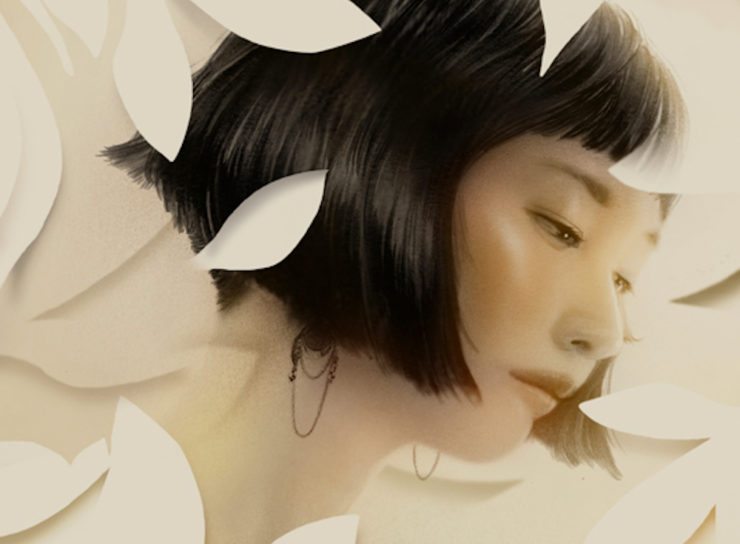The first time I read The Great Gatsby, I was in high school. I grew up in suburban Texas, where it was entirely normal for strangers to open conversations by asking what I was or where I was from, and the glittering world of Jay Gatsby was lovely, dreamlike, and entirely unrelatable. I loved it anyway. It was the same for many of the classics of my childhood and teenage years, which I remember with a hazy, uncritical fondness—Homer, Shakespeare, and more.
I loved these stories because they were the ones I grew up with, the ones that were formative to my growth as a reader and a someday writer. Many of my friends in the Chinese diaspora can cite other stories—the stories of the moon goddess Chang’e, Sun Wukong and the cast of characters in Journey to the West—but my recollections of these are murkier. My parents grew up in the countryside during China’s Cultural Revolution, a period of political and social upheaval, and many of the traditional Chinese legends and stories they either weren’t allowed to learn or didn’t pass down to me. Everything I read—everything I knew—involved Western narratives, white characters inhabiting worlds that I had never imagined or expected to make space for me.
And then I read The Chosen and the Beautiful by Nghi Vo.
It’s a speculative retelling of F. Scott Fitzgerald’s The Great Gatsby, if Gatsby consorted with demons, West Egg ran on nebulous, unknowable magic, and Jordan Baker was a queer Vietnamese American adoptee. And yet to focus on the magic seems to almost do this book a disservice—because at its heart, it’s about Jordan. She’s every bit as competent, aloof, and acerbic as she was in Fitzgerald’s version, but here she’s an Asian American navigating the 1920s in a country on the cusp of passing an immigration ban, a young woman who by turns feels protected by her wealth and family name, confident in who she is, and—increasingly—aware of the difference between her and her white peers. “Demons, foreigners, one’s as bad as the other,” another character remarks in passing.
Even after the past several years of reading Asian-authored SFF, reading Vo’s retelling felt like I had been allowed somewhere that previously had its doors closed to me. Growing up, I had read almost no books by Asian authors. But in college and the years after, the landscape of publishing began to change, and suddenly there was widely available SFF by Asian authors, books that reimagined aspects of my culture, my history, my heritage. Reading books like The Poppy War by R.F. Kuang, She Who Became the Sun by Shelley Parker-Chan, or Daughter of the Moon Goddess by Sue Lynn Tan, I find myself feeling the same way I do when visiting family in China. Nothing is perfectly familiar—there are street names I don’t know, storefronts I can’t always read—but it still feels like home. These stories are fiercely, unapologetically Asian. They taught me that we have a place in SFF, that the publishing world was interested in stories set in non-Western lands, about Asian culture and history.
In some ways, retellings of the Western canon can feel easier to tackle, because they begin from a place that those of us in the Western world are already familiar with. In an industry that’s 76% white, where only 11% of books each year are published by authors of color, there are fewer concerns that readers won’t “get” the source material, that worldbuilding is too complicated, the myths too obscure. On the other hand, though, writing BIPOC-centered retellings comes with its own set of challenges. How do you make it new? How do you make it truthful, when it was written without us in mind?
The Great Gatsby is a story about the American Dream. But it’s a narrow one—focused on whiteness, wealth, and privilege, set in a 1920s where people of color are not given their own agency or depth. The act of retelling a story is to challenge it, to peel back the assumptions of the reader and the author. It’s a love letter to a book, but also a response: This is how I can do it better.
When it comes to The Chosen and the Beautiful, we see the same clear-eyed examination of wealth and status, one that easily parallels contemporary America, but we see the American Dream through the lens of an immigrant, one who gradually realizes that the origin story she was given—that her white mother rescued her from an orphanage in war-torn Vietnam—is a lie, a veneer to cover the truth that she was likely stolen from her birth parents. Thematically, it’s an echo of Jay Gatsby’s own illusions, the narrative of glamour he works so hard to create—but ultimately falls apart—in The Great Gatsby. In both the original and Vo’s retelling, the American Dream exists only in the abstract; upon closer examination, the cracks begin to show through.
Buy the Book


The Chosen and the Beautiful
The Chosen and the Beautiful involves all the small changes one would expect in making The Great Gatsby’s narrator a woman of color, from the casual racism Jordan experiences to the assumptions others make about her, but we also see Jordan’s easy, experienced brush-offs of these slights, the way Daisy weaponizes her beauty and white womanhood in making demands of Jordan, the rising tide of xenophobia that’s a real threat to Jordan but merely an amusing topic of conversation among her wealthy, privileged friends.
While reading, I couldn’t help but think about all the ways that the world is unfriendly to us in ways that others seldom notice—how before Asian Americans were being assaulted on sidewalks or accosted with racial slurs, the everyday pains of existing in America were often brushed beneath the concept of the model minority, the idea of Asian American identity as a single, successful monolith. At the same time, being Asian American is more than what we experience in the hands of others, and Vo’s examination of identity likely feels startlingly familiar to anyone who has grown up as part of two cultures. Jordan is uncomfortable in predominantly Asian settings like Chinatown, “anchored in a strange way by looks that I simultaneously wanted nothing to do with and that I also wanted to recognize me,” and this line echoes how I spent much of my childhood, desperate to be enough of either Chinese or American, willing to give up whichever parts of me I needed to in the process. When Jordan meets other Vietnamese Americans, she feels both superior to them—she is different, she is a Baker—but also a little more herself, learning to hunger for a culture she doesn’t know.
As a Chinese American, as an author, this aspect of The Chosen and the Beautiful brought to mind not only my own struggles with identity, but the pressure authors of color often feel to write with complete accuracy about cultures we have varying ties to in service of authenticity and the white gaze: to perform our background in the same way that Jordan is asked casually, thoughtlessly, about where she is from or to take her friends on a tour of a country she doesn’t remember. The diaspora experience varies widely, and yet authors of color face criticism for anything from supposed factual inaccuracies in loosely inspired fantasy worlds to so-called stereotypical portrayals of their own cultures, limiting the range of stories we feel allowed to tell—and that will receive support from an overwhelmingly white industry.
By the end of The Chosen and the Beautiful, Jordan plans to leave for Shanghai. She’ll go to Vietnam next, her first time visiting since she was stolen as a child. It’s a choice afforded to her by her wealth and position of privilege in society—but also not quite, as the immigration ban has succeeded. Gatsby is dead, Nick is no longer the man he was, and Tom and Daisy are continuing their perfect lives, unaffected by the damage they’ve inflicted on the other characters in the book. In many ways, it ends just as The Great Gatsby does. And yet The Chosen and the Beautiful is at its heart a challenge to the whiteness of the original, a story in which where one can be Asian and American in the same breath, the key around which a classically American tale of wealth, privilege, and excess can turn.
For all the challenges that retellings involve, one thing is always true: When done well, they take a story we’ve always known and make it new again. The Chosen and the Beautiful is one example of this, but it’s not the only one. Chloe Gong’s These Violent Delights sets Romeo & Juliet in 1920s Shanghai, and in addition to being a classic love story, it turns the Montagues and Capulets into Russians and Chinese gangs respectively, fighting each other but also the Western forces looking to conquer Shanghai. Em X. Liu’s forthcoming The Death I Gave Him is an unapologetically queer and Asian take on Shakespeare’s Hamlet, set in a laboratory about a young man searching for the secret to immortality, and Tasha Suri’s What Souls Are Made Of reimagines Wuthering Heights with British Indian protagonists to examine empire, legacy, and loss. For diaspora writers, this sort of reinvention likely feels familiar—haven’t we always known how to arrive in a new place and call it home?
As authors of color, regardless of what kind of story we’re writing, we’re equally influenced by our own heritage and the Western canon. Fonda Lee’s Green Bone Saga draws inspiration from Asian gangster films but also The Godfather, and Ken Liu’s Dandelion Dynasty series leans on both the Chu-Han Contention period of Chinese history and Western epics like Beowulf and the Aeneid. In the world of science fiction, Andrea Tang’s Rebelwing pays homage to both Pacific Rim and Thor: Ragnarok, and Xiran Jay Zhao’s Iron Widow blends Chinese history with The Handmaid’s Tale. Although retellings are the most overt way we reclaim the classics of the Western canon, we’ve been doing this the whole time. Whether it’s Fitzgerald, Shakespeare, or any of the other authors of the Western canon, these stories are ours, just as much as every story from our childhood and culture. When we write them, we rewrite what it means to be American, to exist in the West, and lay claim to a space that should have been ours all along.
We’re from here, after all.
Grace D. Li is a medical student by day and a writer by night. She grew up in Pearland, Texas, and is a graduate of Duke University, where she studied biology and creative writing. She currently attends medical school at Stanford University. Her debut novel, Portrait of a Thief, is forthcoming from Tiny Rep Books (Penguin Random House) and is also in development at Netflix.










